Corporate & Financial Accounting: IFRS, Equity, Australian Banks
VerifiedAdded on 2023/06/07
|11
|2673
|460
Report
AI Summary
This report provides a comprehensive analysis of corporate and financial accounting policies, focusing on the efficiency of the accounting framework and the positive impacts of IFRS standards on organizations, particularly within the Australian banking sector. The report explores corporate regulation, examining the necessity of regulatory control over financial accounting and the limitations of management-led approaches. It delves into accounting standard settings, highlighting Australia's alignment with IFRS guidelines and the role of AASB. An equity analysis of four ASX-listed banks (NAB, CBA, ANZ, and Westpac) is presented, detailing their equity components and accounting policies. Finally, a comparative analysis assesses the debt and equity conditions of these banks, revealing Westpac's robust reporting and the consistent application of accounting principles across the institutions, referencing key legislative acts and frameworks. Desklib offers this and many other solved assignments for students.
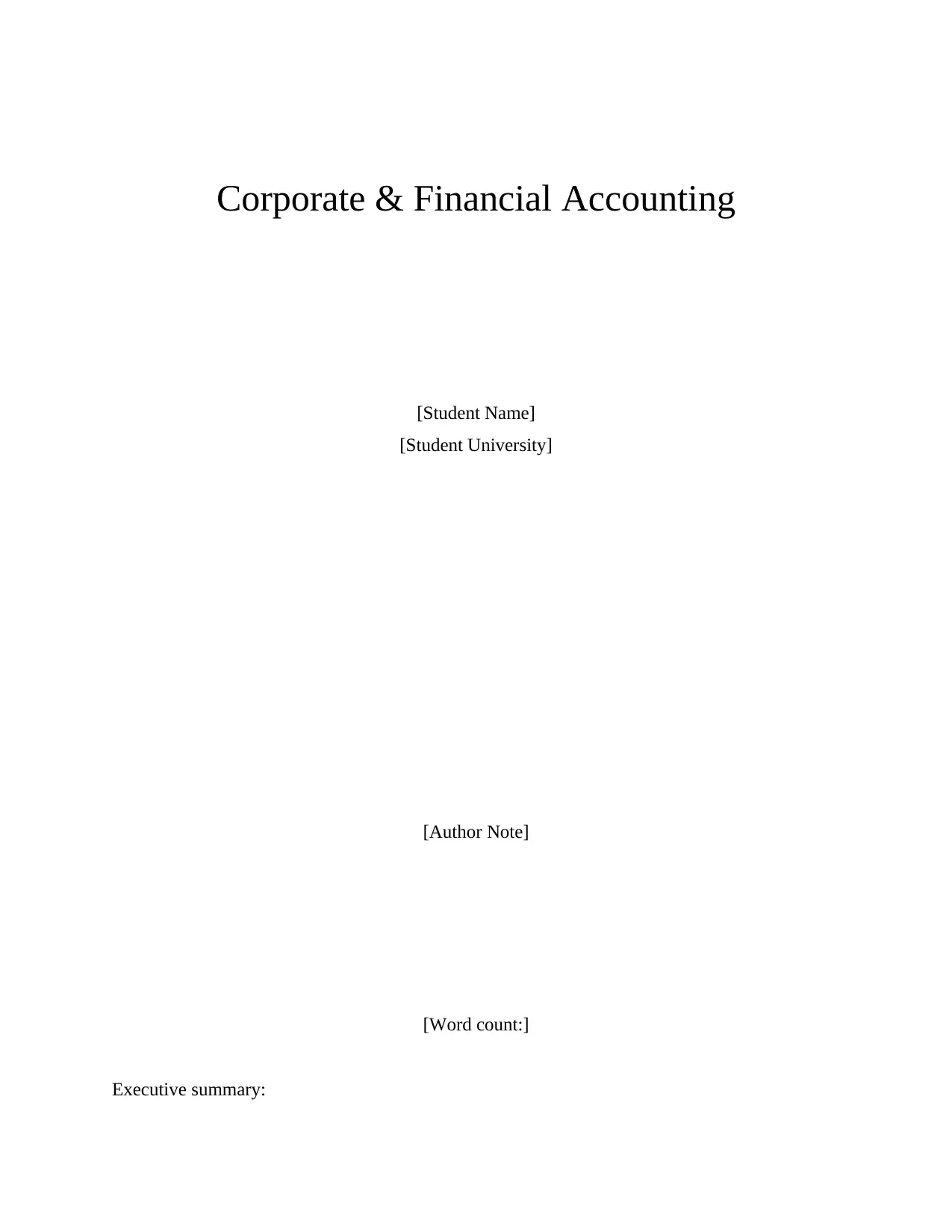
Corporate & Financial Accounting
[Student Name]
[Student University]
[Author Note]
[Word count:]
Executive summary:
[Student Name]
[Student University]
[Author Note]
[Word count:]
Executive summary:
Paraphrase This Document
Need a fresh take? Get an instant paraphrase of this document with our AI Paraphraser
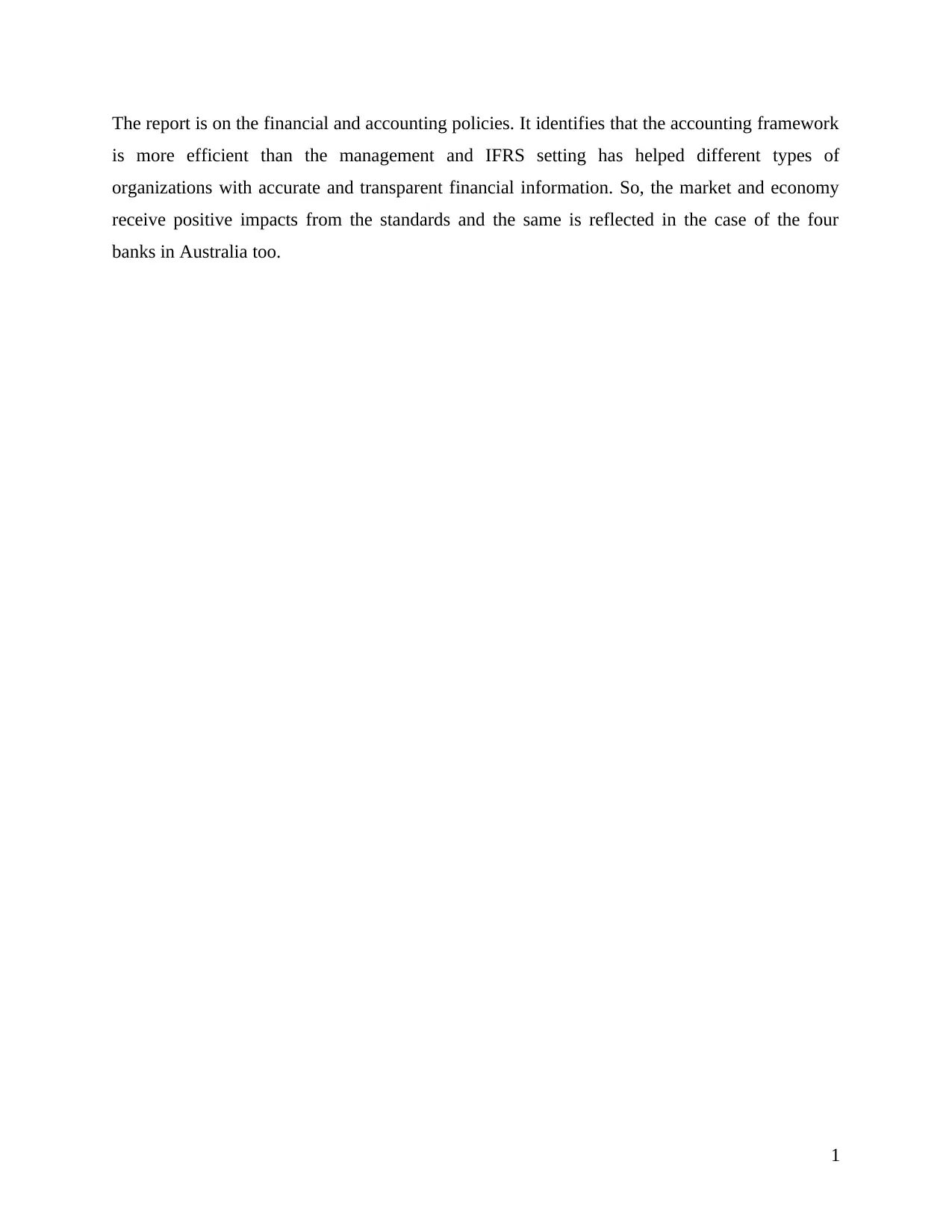
The report is on the financial and accounting policies. It identifies that the accounting framework
is more efficient than the management and IFRS setting has helped different types of
organizations with accurate and transparent financial information. So, the market and economy
receive positive impacts from the standards and the same is reflected in the case of the four
banks in Australia too.
1
is more efficient than the management and IFRS setting has helped different types of
organizations with accurate and transparent financial information. So, the market and economy
receive positive impacts from the standards and the same is reflected in the case of the four
banks in Australia too.
1
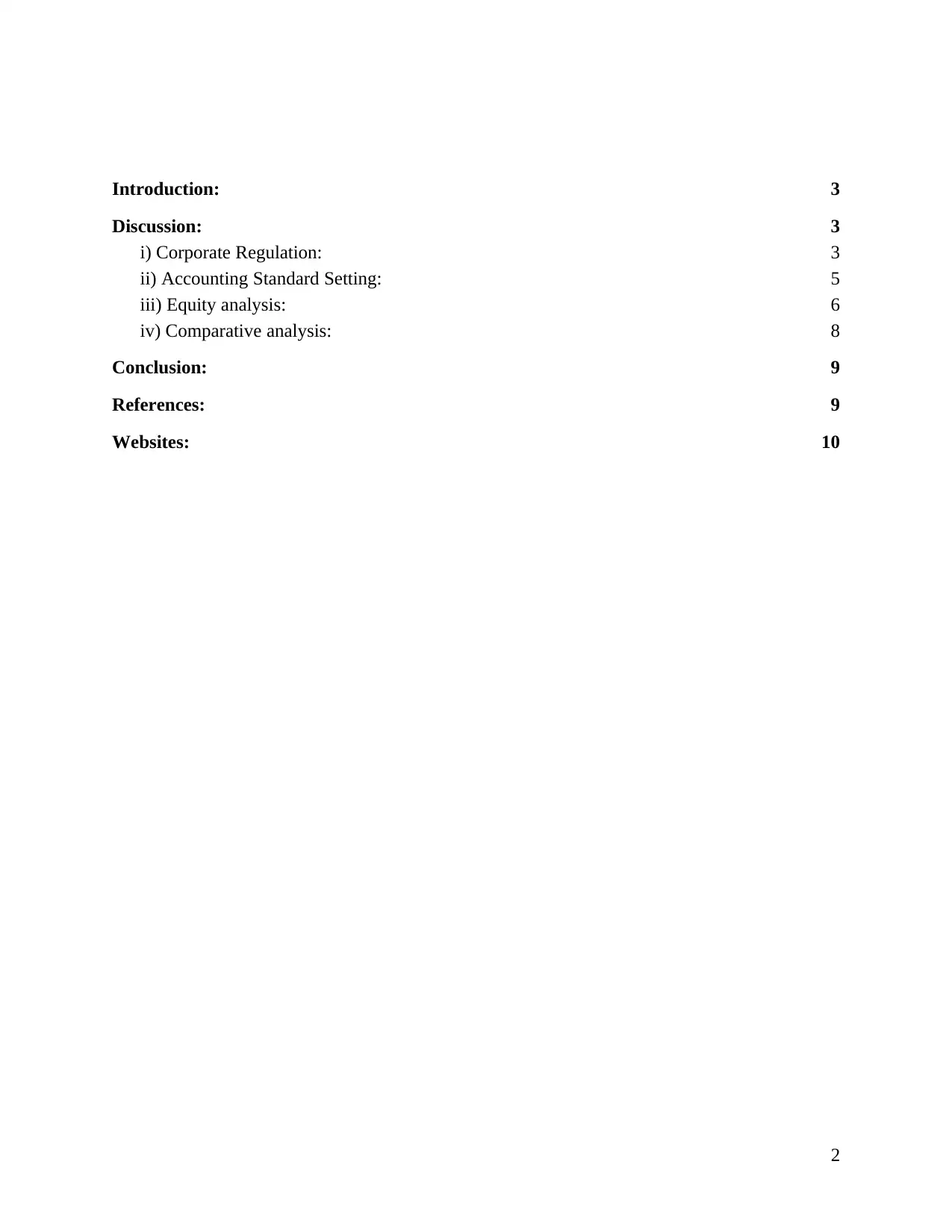
Introduction: 3
Discussion: 3
i) Corporate Regulation: 3
ii) Accounting Standard Setting: 5
iii) Equity analysis: 6
iv) Comparative analysis: 8
Conclusion: 9
References: 9
Websites: 10
2
Discussion: 3
i) Corporate Regulation: 3
ii) Accounting Standard Setting: 5
iii) Equity analysis: 6
iv) Comparative analysis: 8
Conclusion: 9
References: 9
Websites: 10
2
⊘ This is a preview!⊘
Do you want full access?
Subscribe today to unlock all pages.

Trusted by 1+ million students worldwide
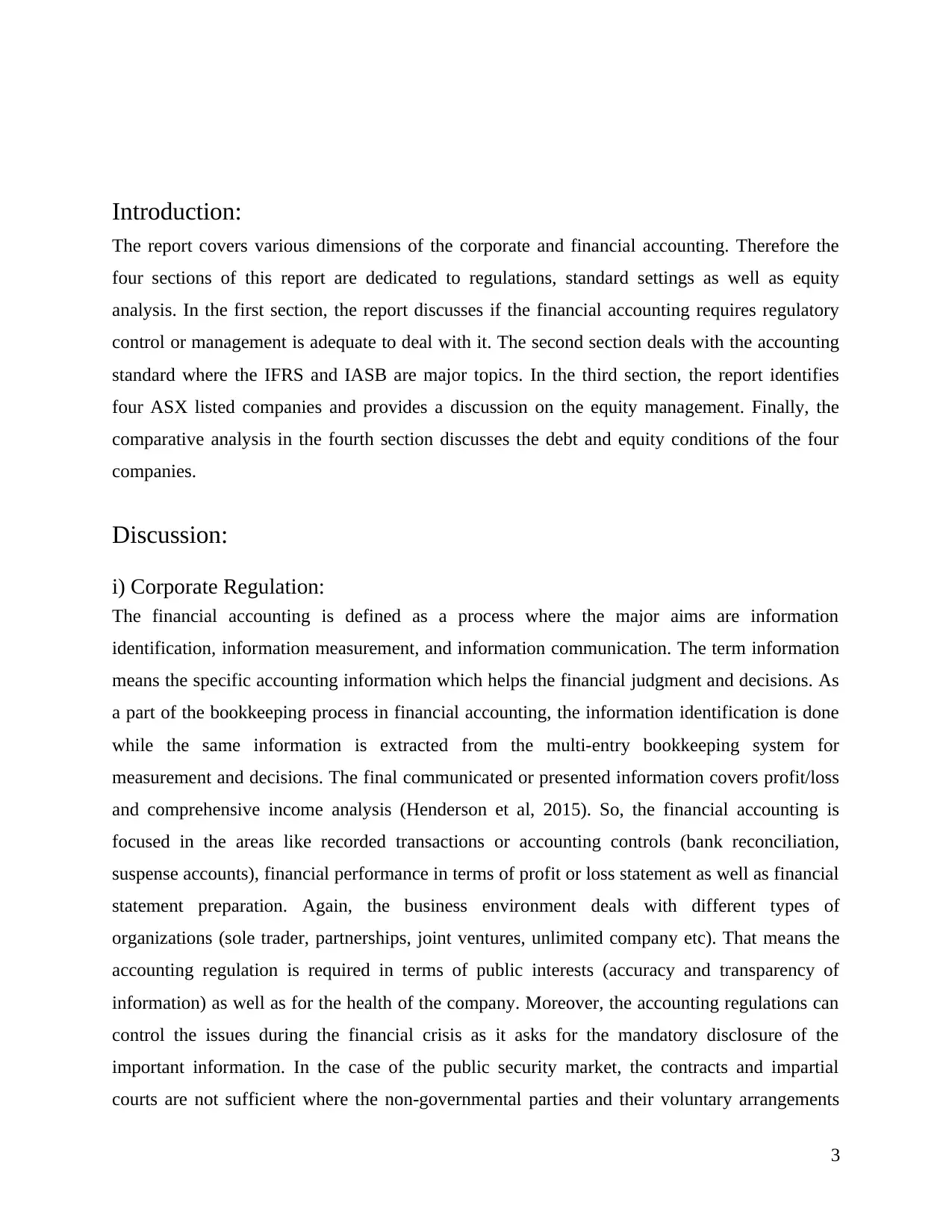
Introduction:
The report covers various dimensions of the corporate and financial accounting. Therefore the
four sections of this report are dedicated to regulations, standard settings as well as equity
analysis. In the first section, the report discusses if the financial accounting requires regulatory
control or management is adequate to deal with it. The second section deals with the accounting
standard where the IFRS and IASB are major topics. In the third section, the report identifies
four ASX listed companies and provides a discussion on the equity management. Finally, the
comparative analysis in the fourth section discusses the debt and equity conditions of the four
companies.
Discussion:
i) Corporate Regulation:
The financial accounting is defined as a process where the major aims are information
identification, information measurement, and information communication. The term information
means the specific accounting information which helps the financial judgment and decisions. As
a part of the bookkeeping process in financial accounting, the information identification is done
while the same information is extracted from the multi-entry bookkeeping system for
measurement and decisions. The final communicated or presented information covers profit/loss
and comprehensive income analysis (Henderson et al, 2015). So, the financial accounting is
focused in the areas like recorded transactions or accounting controls (bank reconciliation,
suspense accounts), financial performance in terms of profit or loss statement as well as financial
statement preparation. Again, the business environment deals with different types of
organizations (sole trader, partnerships, joint ventures, unlimited company etc). That means the
accounting regulation is required in terms of public interests (accuracy and transparency of
information) as well as for the health of the company. Moreover, the accounting regulations can
control the issues during the financial crisis as it asks for the mandatory disclosure of the
important information. In the case of the public security market, the contracts and impartial
courts are not sufficient where the non-governmental parties and their voluntary arrangements
3
The report covers various dimensions of the corporate and financial accounting. Therefore the
four sections of this report are dedicated to regulations, standard settings as well as equity
analysis. In the first section, the report discusses if the financial accounting requires regulatory
control or management is adequate to deal with it. The second section deals with the accounting
standard where the IFRS and IASB are major topics. In the third section, the report identifies
four ASX listed companies and provides a discussion on the equity management. Finally, the
comparative analysis in the fourth section discusses the debt and equity conditions of the four
companies.
Discussion:
i) Corporate Regulation:
The financial accounting is defined as a process where the major aims are information
identification, information measurement, and information communication. The term information
means the specific accounting information which helps the financial judgment and decisions. As
a part of the bookkeeping process in financial accounting, the information identification is done
while the same information is extracted from the multi-entry bookkeeping system for
measurement and decisions. The final communicated or presented information covers profit/loss
and comprehensive income analysis (Henderson et al, 2015). So, the financial accounting is
focused in the areas like recorded transactions or accounting controls (bank reconciliation,
suspense accounts), financial performance in terms of profit or loss statement as well as financial
statement preparation. Again, the business environment deals with different types of
organizations (sole trader, partnerships, joint ventures, unlimited company etc). That means the
accounting regulation is required in terms of public interests (accuracy and transparency of
information) as well as for the health of the company. Moreover, the accounting regulations can
control the issues during the financial crisis as it asks for the mandatory disclosure of the
important information. In the case of the public security market, the contracts and impartial
courts are not sufficient where the non-governmental parties and their voluntary arrangements
3
Paraphrase This Document
Need a fresh take? Get an instant paraphrase of this document with our AI Paraphraser
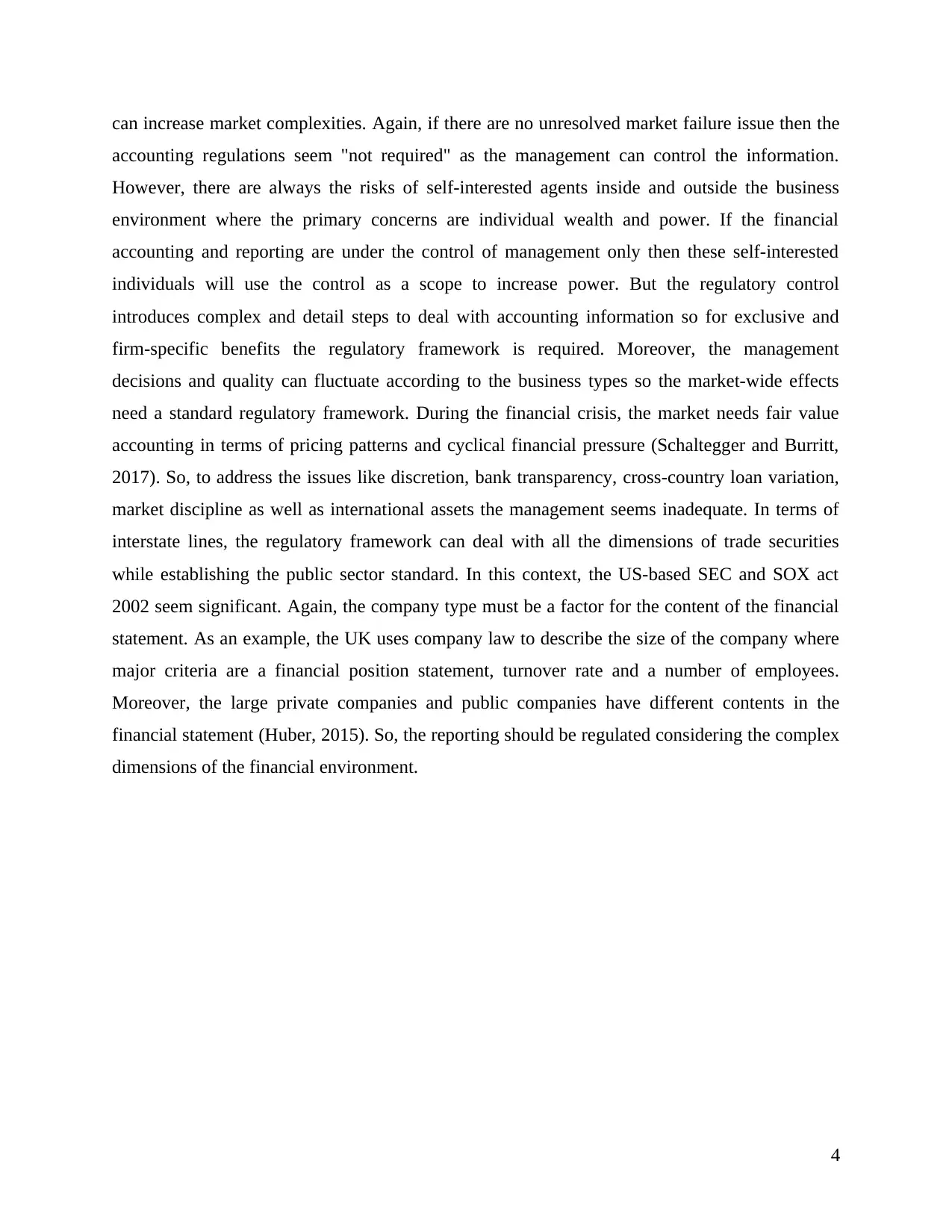
can increase market complexities. Again, if there are no unresolved market failure issue then the
accounting regulations seem "not required" as the management can control the information.
However, there are always the risks of self-interested agents inside and outside the business
environment where the primary concerns are individual wealth and power. If the financial
accounting and reporting are under the control of management only then these self-interested
individuals will use the control as a scope to increase power. But the regulatory control
introduces complex and detail steps to deal with accounting information so for exclusive and
firm-specific benefits the regulatory framework is required. Moreover, the management
decisions and quality can fluctuate according to the business types so the market-wide effects
need a standard regulatory framework. During the financial crisis, the market needs fair value
accounting in terms of pricing patterns and cyclical financial pressure (Schaltegger and Burritt,
2017). So, to address the issues like discretion, bank transparency, cross-country loan variation,
market discipline as well as international assets the management seems inadequate. In terms of
interstate lines, the regulatory framework can deal with all the dimensions of trade securities
while establishing the public sector standard. In this context, the US-based SEC and SOX act
2002 seem significant. Again, the company type must be a factor for the content of the financial
statement. As an example, the UK uses company law to describe the size of the company where
major criteria are a financial position statement, turnover rate and a number of employees.
Moreover, the large private companies and public companies have different contents in the
financial statement (Huber, 2015). So, the reporting should be regulated considering the complex
dimensions of the financial environment.
4
accounting regulations seem "not required" as the management can control the information.
However, there are always the risks of self-interested agents inside and outside the business
environment where the primary concerns are individual wealth and power. If the financial
accounting and reporting are under the control of management only then these self-interested
individuals will use the control as a scope to increase power. But the regulatory control
introduces complex and detail steps to deal with accounting information so for exclusive and
firm-specific benefits the regulatory framework is required. Moreover, the management
decisions and quality can fluctuate according to the business types so the market-wide effects
need a standard regulatory framework. During the financial crisis, the market needs fair value
accounting in terms of pricing patterns and cyclical financial pressure (Schaltegger and Burritt,
2017). So, to address the issues like discretion, bank transparency, cross-country loan variation,
market discipline as well as international assets the management seems inadequate. In terms of
interstate lines, the regulatory framework can deal with all the dimensions of trade securities
while establishing the public sector standard. In this context, the US-based SEC and SOX act
2002 seem significant. Again, the company type must be a factor for the content of the financial
statement. As an example, the UK uses company law to describe the size of the company where
major criteria are a financial position statement, turnover rate and a number of employees.
Moreover, the large private companies and public companies have different contents in the
financial statement (Huber, 2015). So, the reporting should be regulated considering the complex
dimensions of the financial environment.
4
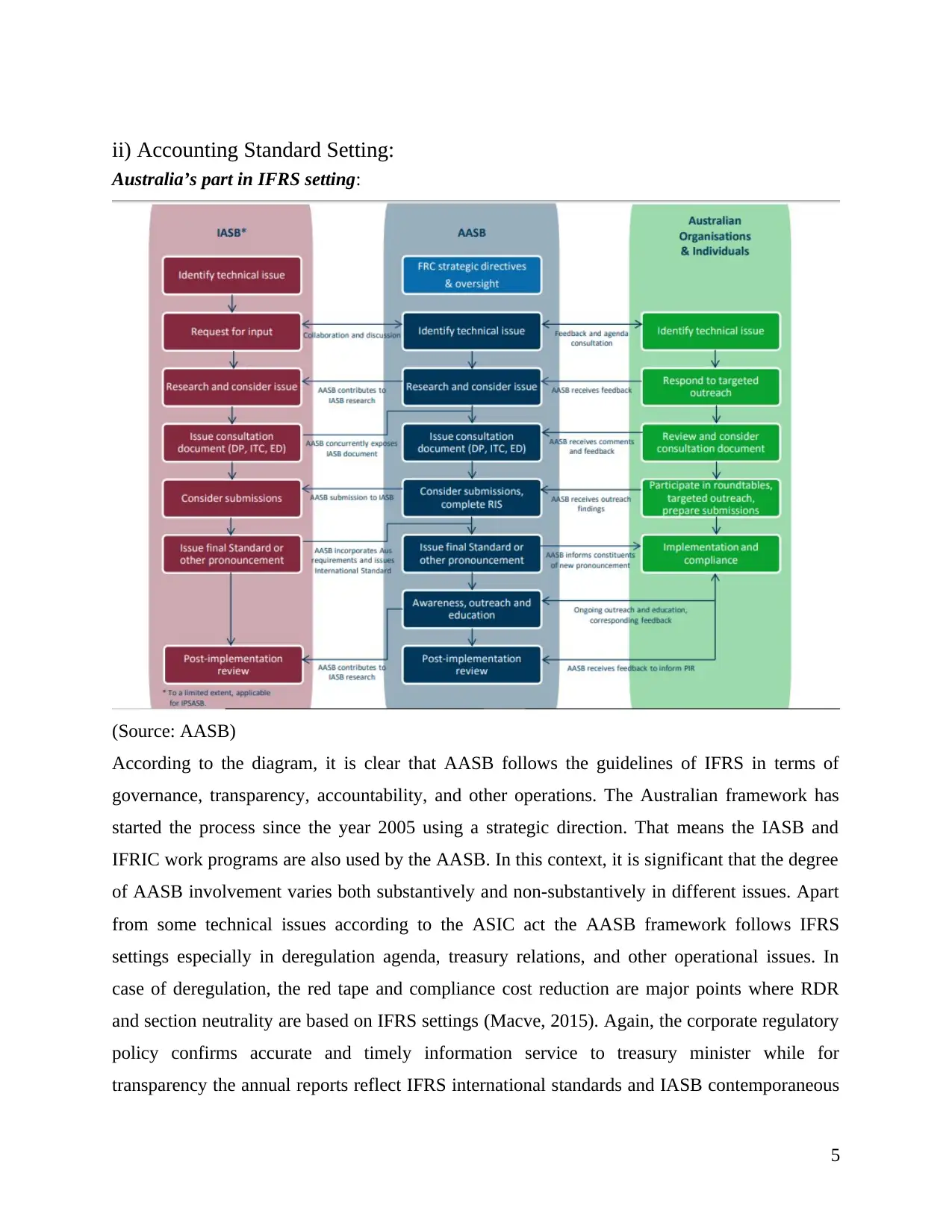
ii) Accounting Standard Setting:
Australia’s part in IFRS setting:
(Source: AASB)
According to the diagram, it is clear that AASB follows the guidelines of IFRS in terms of
governance, transparency, accountability, and other operations. The Australian framework has
started the process since the year 2005 using a strategic direction. That means the IASB and
IFRIC work programs are also used by the AASB. In this context, it is significant that the degree
of AASB involvement varies both substantively and non-substantively in different issues. Apart
from some technical issues according to the ASIC act the AASB framework follows IFRS
settings especially in deregulation agenda, treasury relations, and other operational issues. In
case of deregulation, the red tape and compliance cost reduction are major points where RDR
and section neutrality are based on IFRS settings (Macve, 2015). Again, the corporate regulatory
policy confirms accurate and timely information service to treasury minister while for
transparency the annual reports reflect IFRS international standards and IASB contemporaneous
5
Australia’s part in IFRS setting:
(Source: AASB)
According to the diagram, it is clear that AASB follows the guidelines of IFRS in terms of
governance, transparency, accountability, and other operations. The Australian framework has
started the process since the year 2005 using a strategic direction. That means the IASB and
IFRIC work programs are also used by the AASB. In this context, it is significant that the degree
of AASB involvement varies both substantively and non-substantively in different issues. Apart
from some technical issues according to the ASIC act the AASB framework follows IFRS
settings especially in deregulation agenda, treasury relations, and other operational issues. In
case of deregulation, the red tape and compliance cost reduction are major points where RDR
and section neutrality are based on IFRS settings (Macve, 2015). Again, the corporate regulatory
policy confirms accurate and timely information service to treasury minister while for
transparency the annual reports reflect IFRS international standards and IASB contemporaneous
5
⊘ This is a preview!⊘
Do you want full access?
Subscribe today to unlock all pages.

Trusted by 1+ million students worldwide
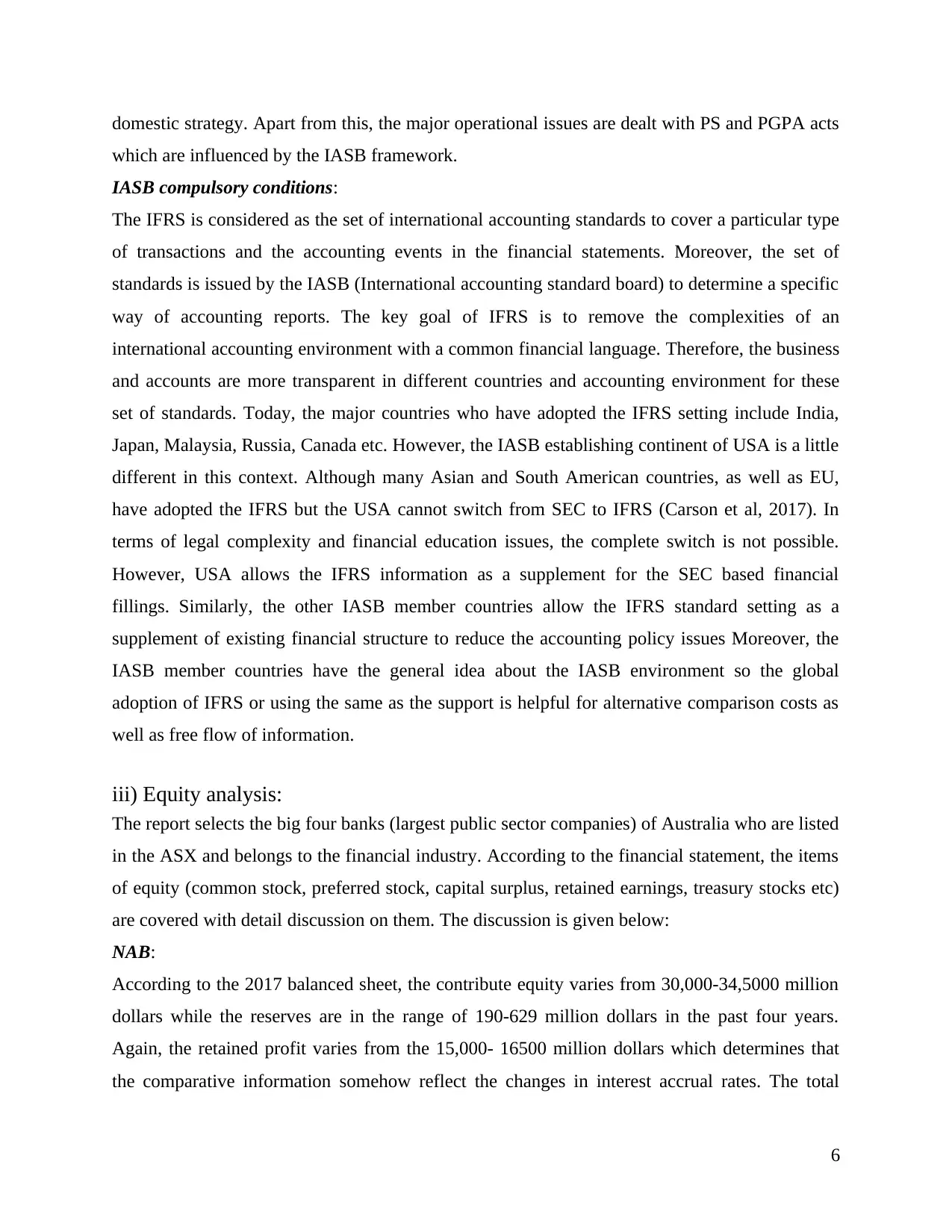
domestic strategy. Apart from this, the major operational issues are dealt with PS and PGPA acts
which are influenced by the IASB framework.
IASB compulsory conditions:
The IFRS is considered as the set of international accounting standards to cover a particular type
of transactions and the accounting events in the financial statements. Moreover, the set of
standards is issued by the IASB (International accounting standard board) to determine a specific
way of accounting reports. The key goal of IFRS is to remove the complexities of an
international accounting environment with a common financial language. Therefore, the business
and accounts are more transparent in different countries and accounting environment for these
set of standards. Today, the major countries who have adopted the IFRS setting include India,
Japan, Malaysia, Russia, Canada etc. However, the IASB establishing continent of USA is a little
different in this context. Although many Asian and South American countries, as well as EU,
have adopted the IFRS but the USA cannot switch from SEC to IFRS (Carson et al, 2017). In
terms of legal complexity and financial education issues, the complete switch is not possible.
However, USA allows the IFRS information as a supplement for the SEC based financial
fillings. Similarly, the other IASB member countries allow the IFRS standard setting as a
supplement of existing financial structure to reduce the accounting policy issues Moreover, the
IASB member countries have the general idea about the IASB environment so the global
adoption of IFRS or using the same as the support is helpful for alternative comparison costs as
well as free flow of information.
iii) Equity analysis:
The report selects the big four banks (largest public sector companies) of Australia who are listed
in the ASX and belongs to the financial industry. According to the financial statement, the items
of equity (common stock, preferred stock, capital surplus, retained earnings, treasury stocks etc)
are covered with detail discussion on them. The discussion is given below:
NAB:
According to the 2017 balanced sheet, the contribute equity varies from 30,000-34,5000 million
dollars while the reserves are in the range of 190-629 million dollars in the past four years.
Again, the retained profit varies from the 15,000- 16500 million dollars which determines that
the comparative information somehow reflect the changes in interest accrual rates. The total
6
which are influenced by the IASB framework.
IASB compulsory conditions:
The IFRS is considered as the set of international accounting standards to cover a particular type
of transactions and the accounting events in the financial statements. Moreover, the set of
standards is issued by the IASB (International accounting standard board) to determine a specific
way of accounting reports. The key goal of IFRS is to remove the complexities of an
international accounting environment with a common financial language. Therefore, the business
and accounts are more transparent in different countries and accounting environment for these
set of standards. Today, the major countries who have adopted the IFRS setting include India,
Japan, Malaysia, Russia, Canada etc. However, the IASB establishing continent of USA is a little
different in this context. Although many Asian and South American countries, as well as EU,
have adopted the IFRS but the USA cannot switch from SEC to IFRS (Carson et al, 2017). In
terms of legal complexity and financial education issues, the complete switch is not possible.
However, USA allows the IFRS information as a supplement for the SEC based financial
fillings. Similarly, the other IASB member countries allow the IFRS standard setting as a
supplement of existing financial structure to reduce the accounting policy issues Moreover, the
IASB member countries have the general idea about the IASB environment so the global
adoption of IFRS or using the same as the support is helpful for alternative comparison costs as
well as free flow of information.
iii) Equity analysis:
The report selects the big four banks (largest public sector companies) of Australia who are listed
in the ASX and belongs to the financial industry. According to the financial statement, the items
of equity (common stock, preferred stock, capital surplus, retained earnings, treasury stocks etc)
are covered with detail discussion on them. The discussion is given below:
NAB:
According to the 2017 balanced sheet, the contribute equity varies from 30,000-34,5000 million
dollars while the reserves are in the range of 190-629 million dollars in the past four years.
Again, the retained profit varies from the 15,000- 16500 million dollars which determines that
the comparative information somehow reflect the changes in interest accrual rates. The total
6
Paraphrase This Document
Need a fresh take? Get an instant paraphrase of this document with our AI Paraphraser
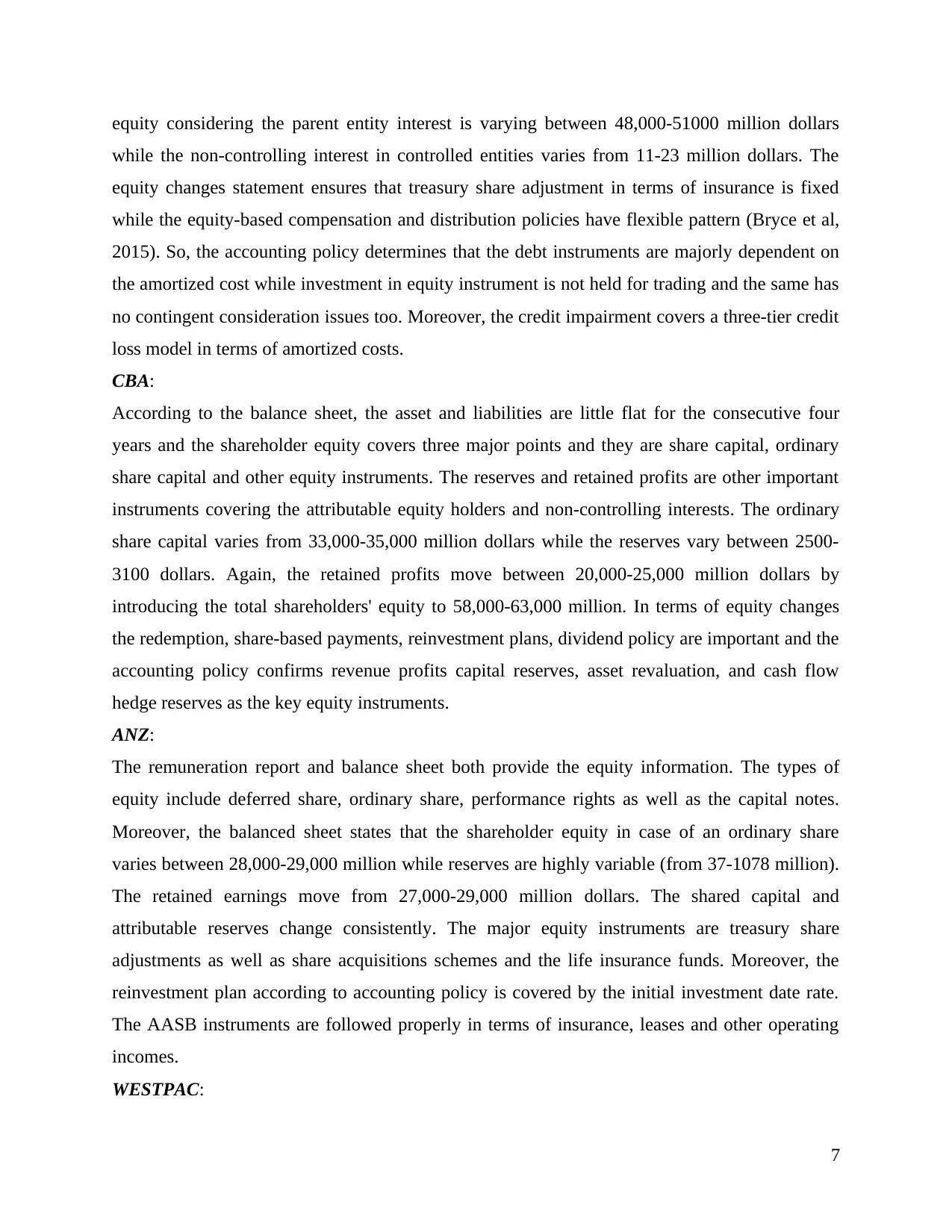
equity considering the parent entity interest is varying between 48,000-51000 million dollars
while the non-controlling interest in controlled entities varies from 11-23 million dollars. The
equity changes statement ensures that treasury share adjustment in terms of insurance is fixed
while the equity-based compensation and distribution policies have flexible pattern (Bryce et al,
2015). So, the accounting policy determines that the debt instruments are majorly dependent on
the amortized cost while investment in equity instrument is not held for trading and the same has
no contingent consideration issues too. Moreover, the credit impairment covers a three-tier credit
loss model in terms of amortized costs.
CBA:
According to the balance sheet, the asset and liabilities are little flat for the consecutive four
years and the shareholder equity covers three major points and they are share capital, ordinary
share capital and other equity instruments. The reserves and retained profits are other important
instruments covering the attributable equity holders and non-controlling interests. The ordinary
share capital varies from 33,000-35,000 million dollars while the reserves vary between 2500-
3100 dollars. Again, the retained profits move between 20,000-25,000 million dollars by
introducing the total shareholders' equity to 58,000-63,000 million. In terms of equity changes
the redemption, share-based payments, reinvestment plans, dividend policy are important and the
accounting policy confirms revenue profits capital reserves, asset revaluation, and cash flow
hedge reserves as the key equity instruments.
ANZ:
The remuneration report and balance sheet both provide the equity information. The types of
equity include deferred share, ordinary share, performance rights as well as the capital notes.
Moreover, the balanced sheet states that the shareholder equity in case of an ordinary share
varies between 28,000-29,000 million while reserves are highly variable (from 37-1078 million).
The retained earnings move from 27,000-29,000 million dollars. The shared capital and
attributable reserves change consistently. The major equity instruments are treasury share
adjustments as well as share acquisitions schemes and the life insurance funds. Moreover, the
reinvestment plan according to accounting policy is covered by the initial investment date rate.
The AASB instruments are followed properly in terms of insurance, leases and other operating
incomes.
WESTPAC:
7
while the non-controlling interest in controlled entities varies from 11-23 million dollars. The
equity changes statement ensures that treasury share adjustment in terms of insurance is fixed
while the equity-based compensation and distribution policies have flexible pattern (Bryce et al,
2015). So, the accounting policy determines that the debt instruments are majorly dependent on
the amortized cost while investment in equity instrument is not held for trading and the same has
no contingent consideration issues too. Moreover, the credit impairment covers a three-tier credit
loss model in terms of amortized costs.
CBA:
According to the balance sheet, the asset and liabilities are little flat for the consecutive four
years and the shareholder equity covers three major points and they are share capital, ordinary
share capital and other equity instruments. The reserves and retained profits are other important
instruments covering the attributable equity holders and non-controlling interests. The ordinary
share capital varies from 33,000-35,000 million dollars while the reserves vary between 2500-
3100 dollars. Again, the retained profits move between 20,000-25,000 million dollars by
introducing the total shareholders' equity to 58,000-63,000 million. In terms of equity changes
the redemption, share-based payments, reinvestment plans, dividend policy are important and the
accounting policy confirms revenue profits capital reserves, asset revaluation, and cash flow
hedge reserves as the key equity instruments.
ANZ:
The remuneration report and balance sheet both provide the equity information. The types of
equity include deferred share, ordinary share, performance rights as well as the capital notes.
Moreover, the balanced sheet states that the shareholder equity in case of an ordinary share
varies between 28,000-29,000 million while reserves are highly variable (from 37-1078 million).
The retained earnings move from 27,000-29,000 million dollars. The shared capital and
attributable reserves change consistently. The major equity instruments are treasury share
adjustments as well as share acquisitions schemes and the life insurance funds. Moreover, the
reinvestment plan according to accounting policy is covered by the initial investment date rate.
The AASB instruments are followed properly in terms of insurance, leases and other operating
incomes.
WESTPAC:
7
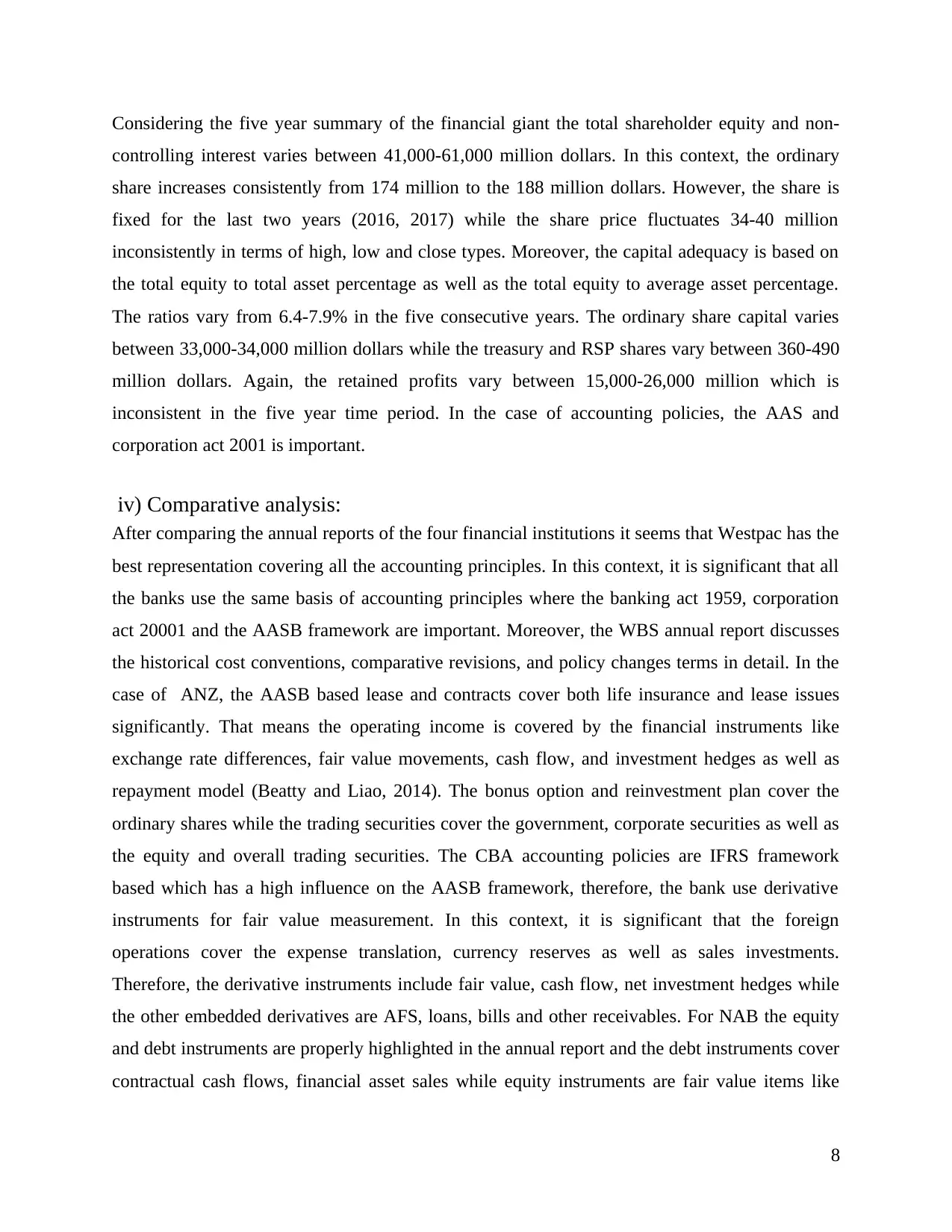
Considering the five year summary of the financial giant the total shareholder equity and non-
controlling interest varies between 41,000-61,000 million dollars. In this context, the ordinary
share increases consistently from 174 million to the 188 million dollars. However, the share is
fixed for the last two years (2016, 2017) while the share price fluctuates 34-40 million
inconsistently in terms of high, low and close types. Moreover, the capital adequacy is based on
the total equity to total asset percentage as well as the total equity to average asset percentage.
The ratios vary from 6.4-7.9% in the five consecutive years. The ordinary share capital varies
between 33,000-34,000 million dollars while the treasury and RSP shares vary between 360-490
million dollars. Again, the retained profits vary between 15,000-26,000 million which is
inconsistent in the five year time period. In the case of accounting policies, the AAS and
corporation act 2001 is important.
iv) Comparative analysis:
After comparing the annual reports of the four financial institutions it seems that Westpac has the
best representation covering all the accounting principles. In this context, it is significant that all
the banks use the same basis of accounting principles where the banking act 1959, corporation
act 20001 and the AASB framework are important. Moreover, the WBS annual report discusses
the historical cost conventions, comparative revisions, and policy changes terms in detail. In the
case of ANZ, the AASB based lease and contracts cover both life insurance and lease issues
significantly. That means the operating income is covered by the financial instruments like
exchange rate differences, fair value movements, cash flow, and investment hedges as well as
repayment model (Beatty and Liao, 2014). The bonus option and reinvestment plan cover the
ordinary shares while the trading securities cover the government, corporate securities as well as
the equity and overall trading securities. The CBA accounting policies are IFRS framework
based which has a high influence on the AASB framework, therefore, the bank use derivative
instruments for fair value measurement. In this context, it is significant that the foreign
operations cover the expense translation, currency reserves as well as sales investments.
Therefore, the derivative instruments include fair value, cash flow, net investment hedges while
the other embedded derivatives are AFS, loans, bills and other receivables. For NAB the equity
and debt instruments are properly highlighted in the annual report and the debt instruments cover
contractual cash flows, financial asset sales while equity instruments are fair value items like
8
controlling interest varies between 41,000-61,000 million dollars. In this context, the ordinary
share increases consistently from 174 million to the 188 million dollars. However, the share is
fixed for the last two years (2016, 2017) while the share price fluctuates 34-40 million
inconsistently in terms of high, low and close types. Moreover, the capital adequacy is based on
the total equity to total asset percentage as well as the total equity to average asset percentage.
The ratios vary from 6.4-7.9% in the five consecutive years. The ordinary share capital varies
between 33,000-34,000 million dollars while the treasury and RSP shares vary between 360-490
million dollars. Again, the retained profits vary between 15,000-26,000 million which is
inconsistent in the five year time period. In the case of accounting policies, the AAS and
corporation act 2001 is important.
iv) Comparative analysis:
After comparing the annual reports of the four financial institutions it seems that Westpac has the
best representation covering all the accounting principles. In this context, it is significant that all
the banks use the same basis of accounting principles where the banking act 1959, corporation
act 20001 and the AASB framework are important. Moreover, the WBS annual report discusses
the historical cost conventions, comparative revisions, and policy changes terms in detail. In the
case of ANZ, the AASB based lease and contracts cover both life insurance and lease issues
significantly. That means the operating income is covered by the financial instruments like
exchange rate differences, fair value movements, cash flow, and investment hedges as well as
repayment model (Beatty and Liao, 2014). The bonus option and reinvestment plan cover the
ordinary shares while the trading securities cover the government, corporate securities as well as
the equity and overall trading securities. The CBA accounting policies are IFRS framework
based which has a high influence on the AASB framework, therefore, the bank use derivative
instruments for fair value measurement. In this context, it is significant that the foreign
operations cover the expense translation, currency reserves as well as sales investments.
Therefore, the derivative instruments include fair value, cash flow, net investment hedges while
the other embedded derivatives are AFS, loans, bills and other receivables. For NAB the equity
and debt instruments are properly highlighted in the annual report and the debt instruments cover
contractual cash flows, financial asset sales while equity instruments are fair value items like
8
⊘ This is a preview!⊘
Do you want full access?
Subscribe today to unlock all pages.

Trusted by 1+ million students worldwide
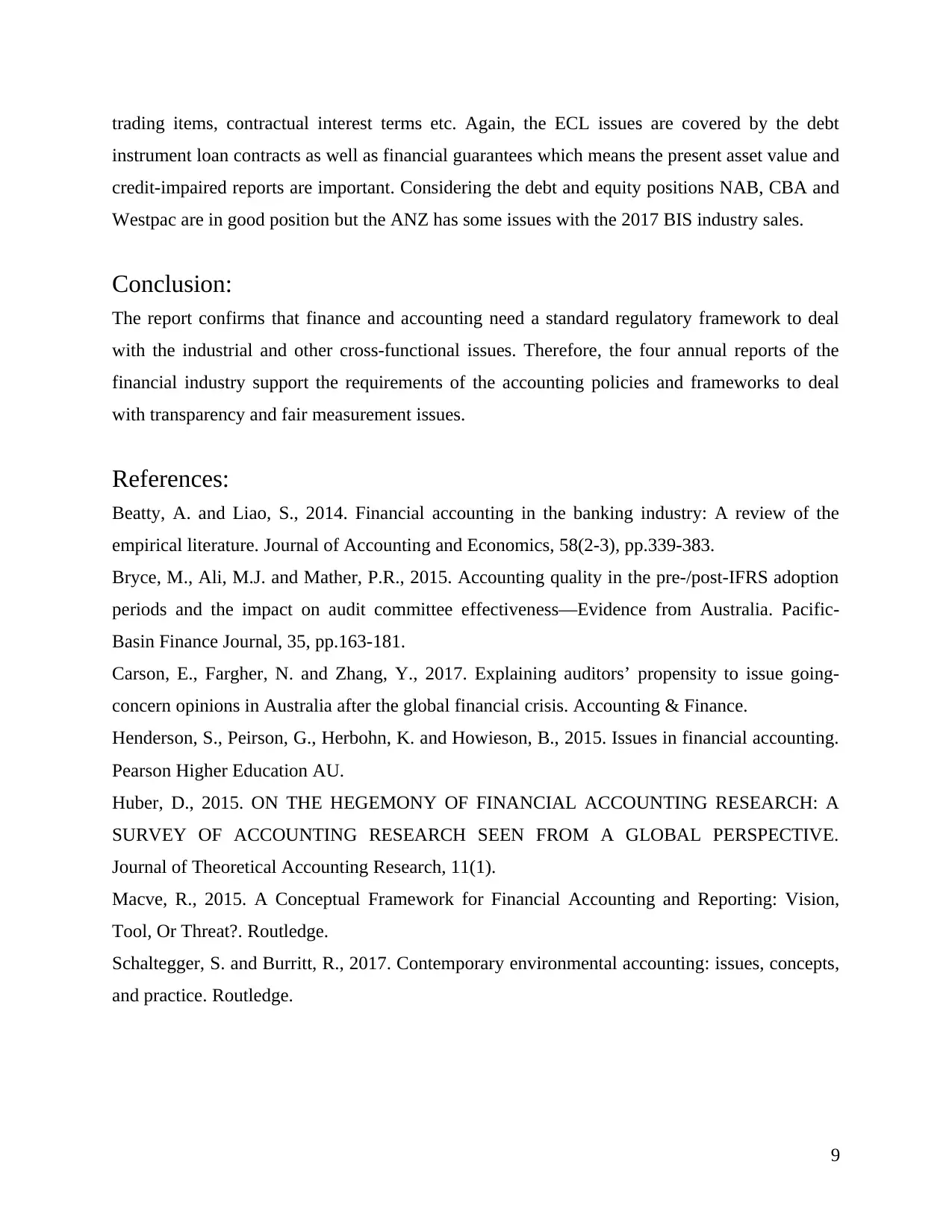
trading items, contractual interest terms etc. Again, the ECL issues are covered by the debt
instrument loan contracts as well as financial guarantees which means the present asset value and
credit-impaired reports are important. Considering the debt and equity positions NAB, CBA and
Westpac are in good position but the ANZ has some issues with the 2017 BIS industry sales.
Conclusion:
The report confirms that finance and accounting need a standard regulatory framework to deal
with the industrial and other cross-functional issues. Therefore, the four annual reports of the
financial industry support the requirements of the accounting policies and frameworks to deal
with transparency and fair measurement issues.
References:
Beatty, A. and Liao, S., 2014. Financial accounting in the banking industry: A review of the
empirical literature. Journal of Accounting and Economics, 58(2-3), pp.339-383.
Bryce, M., Ali, M.J. and Mather, P.R., 2015. Accounting quality in the pre-/post-IFRS adoption
periods and the impact on audit committee effectiveness—Evidence from Australia. Pacific-
Basin Finance Journal, 35, pp.163-181.
Carson, E., Fargher, N. and Zhang, Y., 2017. Explaining auditors’ propensity to issue going‐
concern opinions in Australia after the global financial crisis. Accounting & Finance.
Henderson, S., Peirson, G., Herbohn, K. and Howieson, B., 2015. Issues in financial accounting.
Pearson Higher Education AU.
Huber, D., 2015. ON THE HEGEMONY OF FINANCIAL ACCOUNTING RESEARCH: A
SURVEY OF ACCOUNTING RESEARCH SEEN FROM A GLOBAL PERSPECTIVE.
Journal of Theoretical Accounting Research, 11(1).
Macve, R., 2015. A Conceptual Framework for Financial Accounting and Reporting: Vision,
Tool, Or Threat?. Routledge.
Schaltegger, S. and Burritt, R., 2017. Contemporary environmental accounting: issues, concepts,
and practice. Routledge.
9
instrument loan contracts as well as financial guarantees which means the present asset value and
credit-impaired reports are important. Considering the debt and equity positions NAB, CBA and
Westpac are in good position but the ANZ has some issues with the 2017 BIS industry sales.
Conclusion:
The report confirms that finance and accounting need a standard regulatory framework to deal
with the industrial and other cross-functional issues. Therefore, the four annual reports of the
financial industry support the requirements of the accounting policies and frameworks to deal
with transparency and fair measurement issues.
References:
Beatty, A. and Liao, S., 2014. Financial accounting in the banking industry: A review of the
empirical literature. Journal of Accounting and Economics, 58(2-3), pp.339-383.
Bryce, M., Ali, M.J. and Mather, P.R., 2015. Accounting quality in the pre-/post-IFRS adoption
periods and the impact on audit committee effectiveness—Evidence from Australia. Pacific-
Basin Finance Journal, 35, pp.163-181.
Carson, E., Fargher, N. and Zhang, Y., 2017. Explaining auditors’ propensity to issue going‐
concern opinions in Australia after the global financial crisis. Accounting & Finance.
Henderson, S., Peirson, G., Herbohn, K. and Howieson, B., 2015. Issues in financial accounting.
Pearson Higher Education AU.
Huber, D., 2015. ON THE HEGEMONY OF FINANCIAL ACCOUNTING RESEARCH: A
SURVEY OF ACCOUNTING RESEARCH SEEN FROM A GLOBAL PERSPECTIVE.
Journal of Theoretical Accounting Research, 11(1).
Macve, R., 2015. A Conceptual Framework for Financial Accounting and Reporting: Vision,
Tool, Or Threat?. Routledge.
Schaltegger, S. and Burritt, R., 2017. Contemporary environmental accounting: issues, concepts,
and practice. Routledge.
9
Paraphrase This Document
Need a fresh take? Get an instant paraphrase of this document with our AI Paraphraser
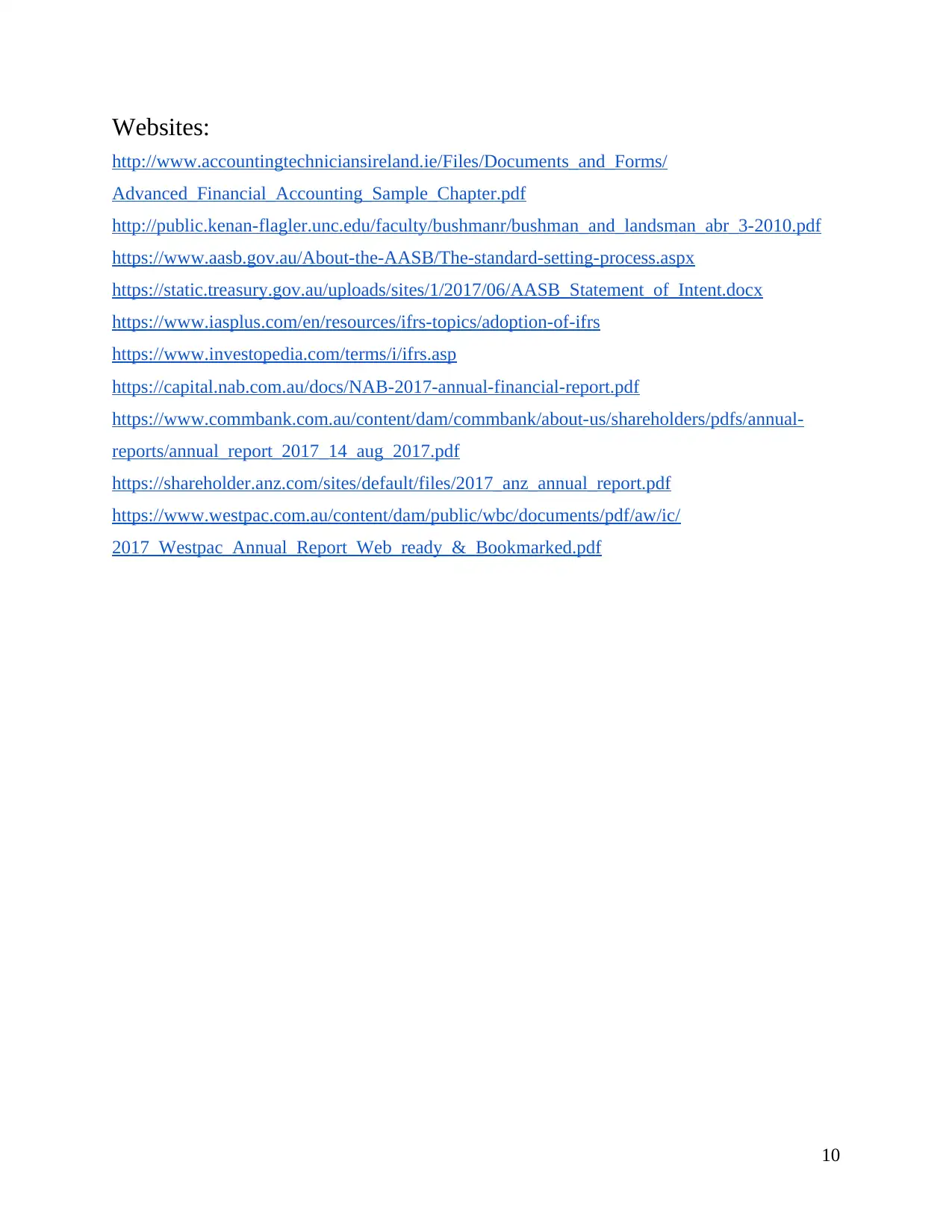
Websites:
http://www.accountingtechniciansireland.ie/Files/Documents_and_Forms/
Advanced_Financial_Accounting_Sample_Chapter.pdf
http://public.kenan-flagler.unc.edu/faculty/bushmanr/bushman_and_landsman_abr_3-2010.pdf
https://www.aasb.gov.au/About-the-AASB/The-standard-setting-process.aspx
https://static.treasury.gov.au/uploads/sites/1/2017/06/AASB_Statement_of_Intent.docx
https://www.iasplus.com/en/resources/ifrs-topics/adoption-of-ifrs
https://www.investopedia.com/terms/i/ifrs.asp
https://capital.nab.com.au/docs/NAB-2017-annual-financial-report.pdf
https://www.commbank.com.au/content/dam/commbank/about-us/shareholders/pdfs/annual-
reports/annual_report_2017_14_aug_2017.pdf
https://shareholder.anz.com/sites/default/files/2017_anz_annual_report.pdf
https://www.westpac.com.au/content/dam/public/wbc/documents/pdf/aw/ic/
2017_Westpac_Annual_Report_Web_ready_&_Bookmarked.pdf
10
http://www.accountingtechniciansireland.ie/Files/Documents_and_Forms/
Advanced_Financial_Accounting_Sample_Chapter.pdf
http://public.kenan-flagler.unc.edu/faculty/bushmanr/bushman_and_landsman_abr_3-2010.pdf
https://www.aasb.gov.au/About-the-AASB/The-standard-setting-process.aspx
https://static.treasury.gov.au/uploads/sites/1/2017/06/AASB_Statement_of_Intent.docx
https://www.iasplus.com/en/resources/ifrs-topics/adoption-of-ifrs
https://www.investopedia.com/terms/i/ifrs.asp
https://capital.nab.com.au/docs/NAB-2017-annual-financial-report.pdf
https://www.commbank.com.au/content/dam/commbank/about-us/shareholders/pdfs/annual-
reports/annual_report_2017_14_aug_2017.pdf
https://shareholder.anz.com/sites/default/files/2017_anz_annual_report.pdf
https://www.westpac.com.au/content/dam/public/wbc/documents/pdf/aw/ic/
2017_Westpac_Annual_Report_Web_ready_&_Bookmarked.pdf
10
1 out of 11
Related Documents
Your All-in-One AI-Powered Toolkit for Academic Success.
+13062052269
info@desklib.com
Available 24*7 on WhatsApp / Email
![[object Object]](/_next/static/media/star-bottom.7253800d.svg)
Unlock your academic potential
Copyright © 2020–2025 A2Z Services. All Rights Reserved. Developed and managed by ZUCOL.




